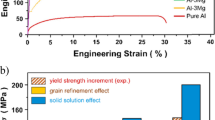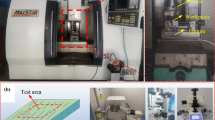Abstract
Referring to extensive use of aluminum alloy (AA) 6061 in various types of industrial divisions, adequate knowledge of factors governing machinability aspects of AA 6061 under different heat treatment conditions (T6, T4, and T651) is important. This subject has received limited attention in the literature. Therefore, surface roughness, cutting force, tool wear as well as burr formation morphology, and chip shape were considered as the main machinability attributes during dry drilling tests. Under specific conditions, the bio-lubricant was used, and the obtained results were compared with those recorded under dry condition. Although heat treatment conditions may increase the hardness of the work parts, consequently higher cutting force and more built up edge were observed under dry condition. Although better machinability was observed under lubricated tests, however, due to interaction effects between cutting parameters, an adequate selection of cutting tool material and geometry as well as lubrication strategy and flow rate are of prime choice in order to improve the machinability of heat treated work parts.







Similar content being viewed by others
References
Aldwell B, Kelly E, Wall R, Amaldi A, O’Donnell GE, Lupoi R (2017) Machinability of Al 6061 deposited with cold spray additive manufacturing. J Therm Spray Technol 26(7):1573–1584
Armendia M, Osborne P, Garay A, Belloso J, Turner S, Arrazola P-J (2012) Influence of heat treatment on the machinability of titanium alloys. Mater Manuf Processes 27(4):457–461
Astakhov VP (2001) Cutting fluids (coolants) and their application in deep-hole machining, pp 1–17. http://viktorastakhov.tripod.com/DH/coolant.pdf
Astakhov VP (2013) Tribology of cutting tools. In: Paulo Davim J (ed) Tribology in manufacturing technology, Springer, pp 1–66
Bagci E, Aykut Ş (2006) A study of Taguchi optimization method for identifying optimum surface roughness in CNC face milling of cobalt-based alloy (stellite 6). Int J Adv Manuf Technol 29(9):940–947
Barry J, Byrne G (2002) Chip formation, acoustic emission and surface white layers in hard machining. CIRP Ann Manuf Technol 51(1):65–70
Bejjani, R (2012) Machinability and modeling of cutting mechanism for titanium metal matrix composites. PhD Thesis, École Polytechnique de Montréal
Cabanettes F, Faverjon P, Sova A, Dumont F, Rech J (2017) MQL machining: from mist generation to tribological behavior of different oils. Int J Adv Manuf Technol 90(1–4):1119–1130
Damir A, Lancereau S, Attia H, Hendrick P (2010) In on the performance of minimum quantity lubrication in milling Al 6061. In: Presented at the 2nd international CIRP conference on process machine, Vancouver, BC, Canada, June 10–11
Davim J, Sreejith P, Gomes R, Peixoto C (2006) Experimental studies on drilling of aluminium (AA1050) under dry, minimum quantity of lubricant, and flood-lubricated conditions. Proc Inst Mech Eng Part B J Eng Manuf 220(10):1605–1611
Di Paola M, Falchero A, Cabibbo M, Evangelista E, Meccia E, Spigarelli S (1998) Mechanical and microstructural characterisation of an aluminum friction stir-welded butt joint. Metall Sci Technol 20(1):17–21
Gajanana S, Reddy BS, Krishnaiah A (2017) Machinability study of aluminium 6061 alloy on end milling process. Int J Eng Res 6(8):397–402
Gogte CL, Likhite A, Peshwe D, Bhokarikar A, Shetty R (2014) Effect of cryogenic processing on surface roughness of age hardenable Aa6061 Alloy. Mater Manuf Process 29(6):710–714
Kamguem R, Djebara A, Songmene V (2013) Investigation on surface finish and metallic particle emission during machining of aluminum alloys using response surface methodology and desirability functions. Int J Adv Manuf Technol 69(5–8):1283–1298
Karnik S, Gaitonde V, Davim J (2008) A comparative study of the ANN and RSM modeling approaches for predicting burr size in drilling. Int J Adv Manuf Technol 38(9):868–883
Khanna N, Rashid RR, Palanisamy S (2017) Experimental evaluation of the effect of workpiece heat treatments and cutting parameters on the machinability of Ti-10V-2Fe-3Al β titanium alloy using Taguchi’s design of experiments. Int J Mach Mach Mater 19(4):374–393
Kilickap E (2010) Modeling and optimization of burr height in drilling of Al-7075 using Taguchi method and response surface methodology. Int J Adv Manuf Technol 49(9):911–923
Kilickap E (2016) Effect of cutting environment and heat treatment on the surface roughness of drilled Al/SiC MMC. Mater Test 58(4):357–361
Kouam J, Songmene V, Balazinski M, Hendrick P (2015) Effects of minimum quantity lubricating (MQL) conditions on machining of 7075–T6 aluminum alloy. Int J Adv Manuf Technol 79(5–8):1325–1334
Kouam J, Songmene V, Zedan Y, Djebara A, Khettabi R (2013) On chip formation during drilling of cast aluminum alloys. Mach Sci Technol 17(2):228–245
Kouam J, Masounave J, Songmene V, Gireadeau A (2010) In pre-holes effect on cutting forces and particle emission during dry drilling machining. In: Presented at the 49th annual conference of metallurgists of CIM, October 3–6
Kumar S, Singh R, Batish A, Singh T (2017) Modeling the tool wear rate in powder mixed electro-discharge machining of titanium alloys using dimensional analysis of cryogenically treated electrodes and workpiece. Proc Inst Mech Eng Part E J Process Mech Eng 231(2):271–282
Lauderbaugh L (2009) Analysis of the effects of process parameters on exit burrs in drilling using a combined simulation and experimental approach. J Mater Process Technol 209(4):1909–1919
Lee S, Saito Y, Sakai T, Utsunomiya H (2002) Microstructures and mechanical properties of 6061 aluminum alloy processed by accumulative roll-bonding. Mater Sci Eng, A 325(1):228–235
Liu C, Liu Y, Ma L, Yi J (2017) Effects of solution treatment on microstructure and high-cycle fatigue properties of 7075 aluminum alloy. Metals 7(6):193
Lombardo S, Rosso M (2017) Heat treatments for aluminum alloys: when, why and how. Mater Perform Charact 6(5):1–16
Macwan A, Mirza F, Bhole S, Chen DL (2017) In Similar and dissimilar ultrasonic spot welding of 5754 aluminum alloy for automotive applications. Mater Sci Forum Trans Tech Publ 877(1):561–568
Madhukar S, Sai PV, Kumar S, Prakash DJ (2017) Experimental investigation on effect of heat treatment on mechanical properties of titanium alloy (Ti-6Al-4V). Int J Curr Eng Technol 7(1):238–242
Mehmood S, Shah M, Pasha RA, Sultan A (2017) Evaluation of fatigue behavior and surface characteristics of aluminum alloy 2024 T6 after electric discharge machining. J Mater Eng Perform 26(10):4910–4922
Mian A, Driver N, Mativenga P (2011) Chip formation in microscale milling and correlation with acoustic emission signal. The Int J Adv Manuf Technol 56(1):63–78
Niknam SA (2017) Modeling and experimental characterization of the friction effects on orthogonal milling exit burrs. Int J Adv Manuf Technol 91(1):1079–1089
Niknam SA, Balazinski M, Songmene V (2017) To characterize and optimize the surface quality attributes in slot milling operation. Int J Adv Manuf Technol 93(1–4):727–746
Niknam SA, Khettabi R, Songmene V (2014) Machinability and machining of titanium alloys: a review. In: Monterio WA (ed) Machining of Titanium Alloys, Springer, Berlin Heidelberg, pp 1–30
Niknam SA, Kouam J, Songmene V (2016) Experimental investigation on part quality and metallic particle emission when milling 6061–T6 aluminium alloy. Int J Mach Mach Mater 18(1–2):120–137
Niknam SA, Songmene V (2013) Simultaneous optimization of burrs size and surface finish when milling 6061–T6 aluminium alloy. Int J Precis Eng Manuf 14(8):1311–1320
Niknam SA, Songmene V (2013) Modeling of burr thickness in milling of ductile materials. Int J Adv Manuf Technol 66(9):2029–2039
Niknam SA, Songmene V (2013a) Factors governing burr formation during high-speed slot milling of wrought aluminium alloys. Proc Inst Mech Eng Part B J Eng Manuf 227(8):1165–1179
Niknam SA, Songmene V (2014) Analytical modelling of slot milling exit burr size. Int J Adv Manuf Technol 73(1–4):421–432
Niknam SA, Songmene V (2015) Milling burr formation, modeling and control: a review. Instit Mech Eng Part B J Eng Manuf 229(6):893–909
Niknam SA, Songmene V (2017) Burr formation and correlation with cutting force and acoustic emission signals. Proc Inst Mech Eng Part B J Eng Manuf 231(3):399–414
Niknam SA, Wygowski W, Balazinski M, Songmene V (2014) Milling burr formation and avoidance. In: Davim JP (ed) Machinability of advanced materials. London, UK, ISTE Wiley, pp 57–94
Niknam SA (2013) Burrs understanding, modeling and optimization during slot milling of aluminium alloys. Ph.D. Thesis, École de Technologie Superieure, Universite du Quebec
Niknam SA, Songmene V (2013) Deburring and edge finishing of aluminum alloys: a review. In: Presented at the 12th international conference on aluminium (INALCO), Montreal, QC, Canada
Niknam SA, Zedan Y, Songmene V (2014) Machining burrs formation & deburring of aluminium alloys. In: Light metal alloys applications, IntechOpen, pp 99–122
Pinto J, Sujaykumar G, Sushiledra R (2016) Effect of heat treatment on mechanical and wear characterization of coconut shell ash and E-glass fiber reinforced aluminum hybrid composites. Am J Mater Sci 6(4A):15–19
Rambabu P, Prasad NE, Kutumbarao V, Wanhill R (2017) Aluminium alloys for aerospace applications. In: Eswara Prasad N, Wanhill RJH (eds) Aerospace materials and material technologies. Springer, pp 29–52
Rashad RM, El-Hossainy TM (2006) Machinability of 7116 structural aluminum alloy. Mater Manuf Processes 21(1):23–27
Santos MC Jr, Machado AR, Sales WF, Barrozo MA, Ezugwu EO (2016) Machining of aluminum alloys: a review. Adv Manuf Technol 86(9–12):3067–3080
Sartkulvanich P (2007) Determination of material properties for use in FEM simulations of machining and roller burnishing. Ph.D Thesis, The Ohio State University, USA
Seo H, Jun J, Jhang K-Y (2017) Assessment of thermal aging of aluminum alloy by acoustic nonlinearity measurement of surface acoustic waves. Res Nondestr Eval 28(1):3–17
Shaw M (1984) Metal cutting principles. Oxford University Press, Oxford
Shivkumar S, Ricci S, Steenhoff B, Apelian D, Sigworth G (1989) An experimental study to optimize the heat treatment of A356 alloy. AFS Trans 97(1):791–810
Shunmugavel M, Polishetty A, Goldberg M, Singh R, Littlefair G (2017) A comparative study of mechanical properties and machinability of wrought and additive manufactured (selective laser melting) titanium alloy–Ti-6Al-4V. Rapid Prototyp J 23(6):1051–1056
Silva CA, Leal LR, Guimarães EC, Júnior PM, Moreira AL, Rocha OL, Silva AP (2018) Influence of thermal parameters, microstructure, and morphology of Si on machinability of an Al–7.0 wt.% Si alloy directionally solidified. Adv Mater Sci Eng. https://doi.org/10.1155/2018/9512957
Songmene V, Djebara A, Zaghbani I, Kouam J, Khettabi R (2011) Machining and machinability of aluminum alloys. IntechOpen, London, pp 377–400
Ulutan D, Ozel T (2011) Machining induced surface integrity in titanium and nickel alloys: a review. Int J Mach Tools Manuf 51(3):250–280
Venkatesh V, Swain N, Srinivas G, Kumar P, Barshilia HC (2017) Review on the machining characteristics and research prospects of conventional microscale machining operations. Mater Manuf Processes 32(3):235–262
Zimmermann M, Schindler S, Aurich J, Steinmann P. (2018) Improvement of the machining accuracy in dry turning of aluminum metal matrix composites via experiments and finite element simulations. In: Thermal effects in complex machining processes, Springer, pp 35–62.
Acknowledgement
The financial support received from FQRNT and NSERC is highly appreciated.
Author information
Authors and Affiliations
Corresponding author
Rights and permissions
About this article
Cite this article
Zedan, Y., Jabbari, K., Niknam, S.A. et al. Machinability Study of AA6061 Under Various Heat Treatment Conditions. Iran J Sci Technol Trans Mech Eng 45, 543–553 (2021). https://doi.org/10.1007/s40997-021-00425-5
Received:
Accepted:
Published:
Issue Date:
DOI: https://doi.org/10.1007/s40997-021-00425-5




